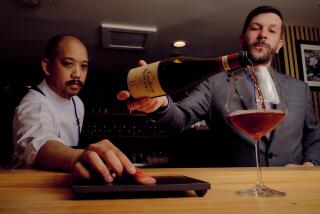Wine Country Cooking : Balancing Act: Matching Food With Wine
John Ash says he has developed a three-part philosophy for matching foods and wine.
“Acidity, pungency and sweetness,” says Ash. “That’s almost all there is. If those elements are in balance with the wine, the dish and the wine will probably match.”
Mark Malicki points out that because of the higher acidity in the wines at Iron Horse than at some wineries, he uses less salt than he might otherwise. Higher-acid wines tend to make it easier to taste subtleties in foods, thus they don’t have to be as highly seasoned or sauced. On the other hand, because of the richness and new-oak aging of so many Beringer wines, Jerry Comfort uses more salt than he might.
For instance, a rich, young Cabernet Sauvignon would go best with steak, but the more mellow the Cabernet, the more it works with lamb or venison. Cabernet’s broad, soft, generous flavors should be matched with something equally flavorful, such as beef.
*
As for Chardonnay, most are not very tart and have oak for richness, so these go well with rich seafood dishes, in cream or butter sauces, and chicken dishes where the spices are delicate and the sauces not based around tart elements such as tomatoes or artichokes.
Where tartness is a main ingredient in the dish, not sweetness, Sauvignon Blanc seems to work better. Thus Sauvignon Blanc works with seafood and light pastas that have delicate, non-tomato-based sauces or olive oil; grilled seafood with lemon sauce; seafood mousses, and grilled chicken in herbs.
Heavier dishes with some tartness--such as pastas based around tomatoes, artichoke-based dishes, and veal with lemon and capers--call for a wine like Chianti. Chianti is a fairly high-acid wine and needs a dish equally tart.
Pungency, Ash says, is a difficult thing to describe. This is an intensity of aroma that is sharp, such as the aroma one might get from raw onions, high-strength vinegar, or limburger cheese.
*
“Take asparagus for example,” he says. “If you steam or boil it, the sulfurous compounds come out, and then it’s hard to match wine with it. What I do is simply grill it. Or take beets. Rather than steam them, I roast them.”
He also likes to use roasted garlic as a “magical ingredient” in many dishes because roasting it tames its pungency and adds a sweetness and a smoky quality to many dishes that is subtle and complex, bringing out the character of many red wines, particularly Pinot Noir.
There is a pungency in grilled and smoked meats, which go better with Zinfandel than with other red wines. Zinfandel also works with rich and spicy pastas, game and sausages.
Sweetness is also a critical issue. Says Comfort: “If the dish is too sweet for the wine, such as a rack of lamb in Port wine sauce, then I’ll reduce the sweetness of the sauce.”
*
But some lightly sweet foods, such as sate, call for lightly sweet wines, such as Gewurztraminer.
Then there is the “sweet” red wine, Pinot Noir, a wine that usually lacks much overt tannin and offers more fruit than Cabernet. Here, tradition calls for prime rib, but the chefs all said it works just as well with the richer seafoods such as salmon and chicken dishes prepared with garlic or other strong seasonings.
Comfort says he is most bothered by what he calls “two romantic wine-food pairings that just don’t work. That is chocolate with Cabernet and Champagne with dessert.” He says the sweetness of the food in both cases wipes out the flavor of the wine.
Malicki says wine works better the fresher the ingredients, and he is especially insistent about the use of fresh herbs whenever possible. “Fresh herbs make wines taste more alive,” he says. If fresh herbs aren’t available, Malicki suggests using only the freshest of dried herbs. “Dried herbs lose their flavor after a time,” he says. “I’d replace them once a year.”
*
Above all, Malicki suggests, cook with the wine you’re going to serve with the meal, or at least something close to it in weight and flavor. This is especially true of sauces that are not cooked for a long period of time, or sauces that don’t call for much or any cream or butter.
Ash said cooking for a winery has taught him to cook differently, to be more sensitive to what the food will taste like with different wines and with specific wines.
“Cooking in the 1990s presents a challenge to all traditional cooks,” he says. “We all need to learn how to cook in a new way. We don’t have demi-glaces any more. There are no hot and cold emulsions, brown sauces, white sauces, tomato sauces.
“We have a whole new set of mother sauces including salsas, chutneys, vinaigrettes, juices and simple stock reductions.” This sort of cooking was spurred by more interest in healthier foods, “and it just happens to work well with wine, if you watch the balance of the dish and the wine.”
*
Ash says there are many versions of such preparations as chutney and vinaigrette. “A lot of vinaigrettes don’t have any vinegar in them at all,” he says, “and chutneys don’t even have to be sweet. They should have a sweet-tart note, but we’re not talking Major Grey’s here.”
For example, a vinaigrette made with lemon juice instead of vinegar might work well with a crisp white wine, and a chutney made only a tiny bit sweet would be a perfect foil for an off-dry Gewurztraminer, Riesling or Chenin Blanc.
“But a Chardonnay might not work with these dishes,” he said. “You just need to watch the balance of the sweetness and the acidity.” And his “secret” is to taste the wine he’s going to serve while preparing the dish.


